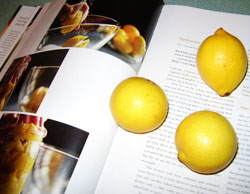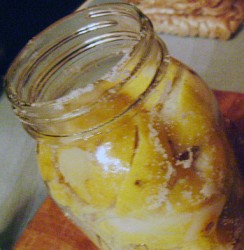 Every culture has their own unique contribution to the culinary world. I was interested by this quote from Chef Mourad Lahlou’s new book, and wanted to share it.
Every culture has their own unique contribution to the culinary world. I was interested by this quote from Chef Mourad Lahlou’s new book, and wanted to share it.
” I’m going to go out on a limb here- the limb of a lemon tree- and say that preserved lemons are Morocco’s greatest culinary contribution to the world. No, wait, I’m going to say this: they are Morocco’s greatest contribution to the world, PEROID.” After reading this, I was intrigued. I had never experienced the pleasure of a preserved lemon. He compares them to olives and pickles because they are cured and fermented in heavy salt. He then goes on to explain that in contrast they are not an appetizer to nibble, but an addition to savory dishes that brings, “saltiness, acidity, and a perfumy citrus.” With words like “mouthwateringness,” and “intoxicating intensity,” I was inspired to create this “gift from Morocco.”
I preserved the lemons, according to Lahlou’s instructions and they turned out perfectly. First you will need to gather your supplies and ingredients. You will need a quart sized jar with a wide mouth. You will also need kosher salt, because it has a clean iodine free flavor. You will also need 12 lemons. Don’t use the traditional grocery store lemons. You will want  to buy organic and pesticide free lemons. Lahlou recommends Eureka or Lisbon lemons. I could find neither at the co-op I visited. I instead bought a bag of meyer lemons at a local co-op, and they worked beautifully.
to buy organic and pesticide free lemons. Lahlou recommends Eureka or Lisbon lemons. I could find neither at the co-op I visited. I instead bought a bag of meyer lemons at a local co-op, and they worked beautifully.
The Process:
About 6 lemons for juicing
About 6 lemons for preserving
About a 1/2 cup kosher salt
Scrub the lemons you plan to preserve under cold running water, and then pat dry.
*** TIP: Zest the lemons you plan to juice, spread the zest on a parchment lined baking sheet, cover tightly with plastic wrap, and freeze once frozen, place in a freezer bag for later use.***
Pour the salt into a large bowl. Stand the lemon stem side down and cut into lemon as if you were going to half it, but stop a 1/2 inch above the bottom. Now make a perpendicular cut, also stopping 1/2 above the stem. Next you hold the lemon over the bowl of salt, and pack as much salt as you can into the cuts in the lemon. He says to really pack it in here. Next you place the lemon in the jar cut side up, so the salt does not spill out. Pack as many as you can into the jar, pushing down hard so they’re squeezed in tightly. Put the lid on the jar, and leave out overnight.
The next day use a clean spoon to pack them tighter, and add as many as you can to fill the jar. Juice the remaining lemons, and add the juice to the jar. When the lemons are submerged, tighten the lid and place in a cool, dark spot to preserve. Don’t tighten the lid too much, as this may cause it to buckle. I had to add a little juice after the first week, to  make sure the lemons stayed submerged. I checked on my lemons every few days, turning the jar upside down to redistribute the juices and salt through the jar. That is all there is to it! I marked the date on the calender when they would be ready, so I wouldn’t forget. Then lemons take 1 month to preserve. In the meantime, don’t be concerned if there is a little bubbling around the edge of the jar. That is a normal part of the fermentation process. Your lemons may also turn a little brown, which is also normal.
make sure the lemons stayed submerged. I checked on my lemons every few days, turning the jar upside down to redistribute the juices and salt through the jar. That is all there is to it! I marked the date on the calender when they would be ready, so I wouldn’t forget. Then lemons take 1 month to preserve. In the meantime, don’t be concerned if there is a little bubbling around the edge of the jar. That is a normal part of the fermentation process. Your lemons may also turn a little brown, which is also normal.
That is all there is to it. Open your jar a month later, cut a piece off a lemon, and pop it into your mouth. You will find the lemon to be a little bitter and very salty. I plan to share with you the recipe I specifically preserved my lemons to make. Until then, do you have any recipes you would like to share that incorporate preserved lemons?
Here are a few recipes I have found on other blogs that I would recommend trying…
Melissa Clark’s “Sauteed Scallops with Tomatoes and Preserved Lemon”
Erika’s Kitchen “Garbanzo green garlic hummus recipe with preserved lemon and sesame seeds”
